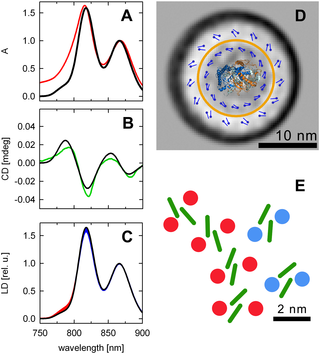PLOS Biology ( IF 9.8 ) Pub Date : 2017-12-18 , DOI: 10.1371/journal.pbio.2003943 Marko Dachev , David Bína , Roman Sobotka , Lenka Moravcová , Zdenko Gardian , David Kaftan , Václav Šlouf , Marcel Fuciman , Tomáš Polívka , Michal Koblížek

|
The majority of life on Earth depends directly or indirectly on the sun as a source of energy. The initial step of photosynthesis is facilitated by light-harvesting complexes, which capture and transfer light energy into the reaction centers (RCs). Here, we analyzed the organization of photosynthetic (PS) complexes in the bacterium G. phototrophica, which so far is the only phototrophic representative of the bacterial phylum Gemmatimonadetes. The isolated complex has a molecular weight of about 800 ± 100 kDa, which is approximately 2 times larger than the core complex of Rhodospirillum rubrum. The complex contains 62.4 ± 4.7 bacteriochlorophyll (BChl) a molecules absorbing in 2 distinct infrared absorption bands with maxima at 816 and 868 nm. Using femtosecond transient absorption spectroscopy, we determined the energy transfer time between these spectral bands as 2 ps. Single particle analyses of the purified complexes showed that they were circular structures with an outer diameter of approximately 18 nm and a thickness of 7 nm. Based on the obtained, we propose that the LH complexes in G. phototrophica form 2 concentric rings surrounding the type 2 RC. The inner ring (corresponding to the B868 absorption band) is composed of 15 subunits and is analogous to the inner light-harvesting complex 1 (LH1) in purple bacteria. The outer ring is composed of 15 more distant BChl dimers with no or slow energy transfer between them, resulting in the B816 absorption band. This completely unique and elegant organization offers good structural stability, as well as high efficiency of light harvesting. Our results reveal that while the PS apparatus of Gemmatimonadetes was acquired via horizontal gene transfer from purple bacteria, it later evolved along its own pathway, devising a new arrangement of its light harvesting complexes.
中文翻译:

芽孢杆菌营养光中光收集复合物的独特双同心环组织
地球上的大多数生命直接或间接依赖太阳作为能源。光合作用促进了光合作用的起始步骤,光捕获配合物捕获光能并将光能转移到反应中心(RC)中。在这里,我们分析了细菌G中光合作用(PS)配合物的组织。phototrophica,到目前为止,它是细菌门菌门的唯一光养代表。分离的复合物的分子量为约800±100kDa,约比红螺螺旋螺菌的核心复合物大2倍。该复合物含有62.4±4.7细菌叶绿素(BChl)a分子在2个不同的红外吸收带中吸收,最大吸收波长为816和868 nm。使用飞秒瞬态吸收光谱法,我们将这些光谱带之间的能量转移时间确定为2 ps。对纯化的复合物进行单颗粒分析表明,它们是圆形结构,外径约为18 nm,厚度为7 nm。根据获得的结果,我们提出G中的LH络合物。光养形成围绕2型RC的2个同心环。内环(对应于B868吸收带)由15个亚基组成,类似于紫色细菌中的内集光复合体1(LH1)。外环由15个距离较远的BChl二聚体组成,它们之间没有能量传递或能量传递缓慢,从而形成了B816吸收带。这种完全独特而优雅的组织提供了良好的结构稳定性,以及高效率的采光。我们的研究结果表明,虽然通过水平基因转移从紫色细菌中获得了芽孢杆菌的PS装置,但后来它沿着其自身的途径进化,从而设计了一种新的光收集复合体排列方式。



























 京公网安备 11010802027423号
京公网安备 11010802027423号